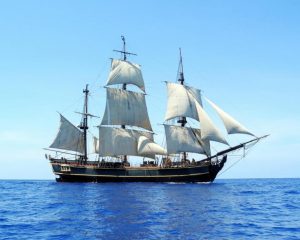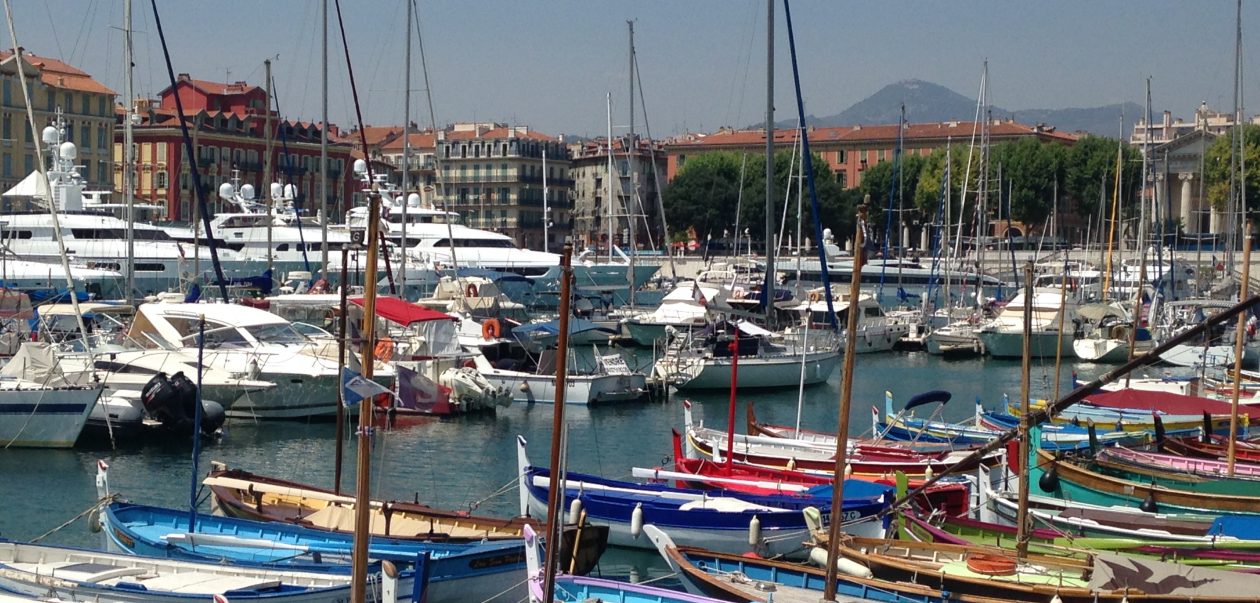My Bolt family originates in Cornwall, England. The earliest Bolt ancestor that we know of is a William Bolt, who was born, we estimate, about 1778. In 1799, he married a Hannah (or Anne) Ham in the church at St. Austell. On the marriage certificate, Willam’s occupation was entered as a member of the Royal Artillery.
A grandson of William, Reuben James Bolt, in 1869 at Veryan, Cornwall, married Ellen Ann Rundle. Ellen Ann’s father, John Quintrell Rundle, had a second cousin named Mathew Quintrell. Born 1766 at Padstow, Cornwall. Matthew had an interesting career as a sailor: he was one of the leaders of the famous mutiny on the HMS Bounty.

The Bounty sailed with a crew of 46 in December 1787, bound for the South Seas, her mission under the command of Captain William Bligh being to collect breadfruit trees from Tahiti and spread their growth to other South Sea Islands.
Matthew Quintrell is described as being 5 feet 5 inches in height, strongly built, “…with a fair complexion, light brown hair and very much tattooed on his back, legs, and backside.”
Mathew—whose surname was entered on the Bounty’s roster as “Quintal”—had the dubious honor, four months into the voyage, of being the first seaman on board to undergo disciplinary punishment, being lashed for refusing to eat pumpkin, which had been purchased at Tenerife as a substitute for bread.
Bligh noted in his log: “Until this Afternoon I had hopes I could have performed the Voyage without punishment to any One, but I found it necessary to punish Mathew Quintal with a dozen lashes for Insolence and Contempt.”
Such a punishment would have been an excruciating ordeal: “… the crew mustered to watch Quintal, age twenty-two, from Cornwall, striped to the waist and strapped, spread-eagled, by the wrists and ankles to an upright deck grating. With no marines to drum or pipe, this would have been a lackluster ceremony, itself stripped down to its most pertinent and brutal elements.” (Caroline Alexander. The Bounty, p. 87.)
Quintal was the first of the crewmen to be approached by Fletcher Christian, master’s mate on the Bounty, concerning the possibility of a mutiny; Quintal initially was reluctant, but later became a supporter of Christian.
Of the mutiny itself, Bligh wrote: “Just before sunrise Mr Christian and the Master at Arms came into my cabin while I was fast asleep, and seizing me tied my hands with a cord and threatened instant death if I made the least noise. I however called sufficiently loud to alarm the officers, who found themselves equally secured by sentinels at their door. There were now three men at my cabin door and four inside. Fletcher Christian, Alexander Smith, John Sumner and Matthew Quintal.”
Captain Bligh and eighteen of his crew were put into a small boat, with which they sailed for 3000 miles through the South Seas to eventual landfall, their voyage itself a classic tale of survival. The Bounty, under the command of Fletcher Christian, set sail for Tahiti, where all but nine of the mutineers chose to remain. These nine English sailors, along with four native men—whether willing or not is unclear—and eleven young native women, made for the tiny, remote island of Pitcairn, intending “…to settle in undisturbed peace and tranquility.”
At Pitcairn, the Bounty was stripped of all that could be taken ashore. There was a dispute as to whether to keep the Bounty intact in case of a later need to escape, or to dismantle it for wood and nails to build shelter. While the dispute went on, Quintal settled the issue by setting fire to the ship.
Soon the intended paradise on Pitcairn turned into a sorrowful trial. Jealousy and drunkenness prevailed. Seaman McCoy used his knowledge of distilling to concoct an extremely potent drink from the “tee root” (Dracoena terminalis) plant. McCoy and Quintal produced copious streams of the liquor, which in time drove McCoy insane and led to the four Tahitian men, whom they had taken from the island, being flogged and hung in irons. Two of the Tahitians escaped and somehow secured muskets, with which they fled. Later returning, they attacked the white men, killing Fletcher Christian and seamen Williams, Mills, Martin and Brown. McCoy and Quintal fled for the hills of the tiny island, which measured only one by two miles, and hid.
The Tahitian men now held most of the weapons, all of the liquor, and the eleven women. After a drunken fight over one of the women, one Tahitian shot another and fled to join McCoy and Quintal, who promptly murdered him for his musket. The two remaining Tahitian men were turned against by the women; one was axed to death, the other was shot by Edward Young. The remaining people on the island somehow made up their differences, and for a good while lived in peace.
Three years later, in 1797, McCoy, drunken and depressed, committed suicide by throwing himself off a cliff with a rock tied around his neck. A couple of years later, one of Quintal’s women slipped and fell from a cliff while collecting bird’s eggs. Quintal, drunk and crazy, demanded Edward Young’s woman from him, despite there being other women who were unattached. Adams and Young decided for self-protection to kill Quintal, which they did by setting upon him with an ax while he lay in a drunken stupor.
Unquestionably one of the most violent of the crew members, Quintal seemed yet to have a feeling for family, not only naming his Tahitian consort after his mother, but naming each of his children after a member of his family.
A year later, in 1800, Young died, the first of the mutineers to die of natural causes. This left John Adams, age 33, the only surviving English seaman on the island. With him were nine Polynesian women, one eleven old Polynesian girl, and twenty-three children born on the island, several of whom fathered by Matthew Quintal.
Upon the death of Adams in 1829, charge of the island’s affairs was taken over by one of Quintal’s sons, Edward, who, according to Adams, possessed the “… best understanding of any on the island.”
Two years later, missionaries removed all of the settlers to Norfolk Island.
The descendants of Matthew Quintrell currently form the largest grouping of blood relatives on Norfolk Island. To this day, there are many of Matthew’s descendants living in Australia, New Zealand, and elsewhere. (I, Richard Bolt, am not a descendent of Matthew, but a second cousin, 4 times removed.)
Interestingly, the movie actor Errol Flynn (1909 – 1959) may have been a descendent of Quintal. Flynn’s maternal grandfather, Frederick Richmond Young (1860 – 1918)—himself descended from mutineers Edward Young and John Adams and their Tahitian consorts—married as his second wife Esther Linda Quintal, a g-g-granddaughter of Matthew Quintal. However, some on-line genealogies of Flynn’s mother Lily Mary Young list her as born to Young’s first wife Annie Edith Madden (e.g., on Geni; Ancestry), while others (e.g., on WikiTree) cite second wife Esther Quintal.
* * * * * *
A number of passages in the foregoing account are quoted or paraphrased from the magazine article: “The Padstow Mutineer” by Chris Pollard. In Cornwall Today, August 1995.
Also from: “Descendents of Matthew Quintrell and Hannah Brent.” Compiled by Mr. Paul J. Lareau.
Also referenced is Caroline Alexander’s The Bounty. Viking, 2003.
